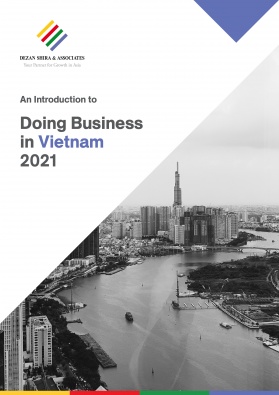Vietnam’s Ride Hailing Industry: Trends, Opportunities, and Risks
- Vietnam’s ride-hailing industry could reach US$4 billion by 2025 and is one of Southeast Asia’s fastest-growing ride-hailing markets.
- Multiple new entrants are challenging the market positions of established firms while the latter attempt to expand networks by entering industries such as food and package delivery, and shopping services.
- Vietnam recently categorized ride-hailing firms as ‘transportation firms’ as opposed to their initial categorization as ‘technology firms’. This has increased compliance costs and tax incidence which significantly affect the financial relationship between firms, drivers, and consumers.
Vietnam’s ride-hailing industry revenues could reach US$4billion by 2024, while the industry is forecasted to grow at a compound annual growth rate (CAGR) of 16 percent between 2020 and 2025. The industry has witnessed a surge in consumer demand, new entrants, and innovative products in recent years.
In addition, since the industry is relatively nascent the regulatory outlook is constantly evolving. Foreign firms have a strong presence in the industry and many established firms are expanding into associated services such as food delivery, service hire, and shopping services.
Ride-hailing connects consumers to drivers for the purpose of providing transportation services based on short-term contracts. While traditional taxi services offer the same value, ride-hailing operates through digital interfaces such as mobile apps.
These apps reduce search costs for consumers who now spend lesser time finding a service provider and agreeing at a price. Similar to other industries in the digital economy, ride-hailing is a network-based business; firms benefit from their ability to establish and connect a network of consumers and drivers. Consumer value is created by product quality, ease of use, and innovation in digital banking. E-wallets in particular are a key component of many ride-hailing services.
Key drivers
Numerous factors collectively contribute to the rise of Vietnam’s ride-hailing industry. Of these, internet penetration and digital financial services are the most significant.
In 2015, the internet access rate in the country was 45 percent; by 2019, this figure grew to 69 percent. Particularly in urban areas, a large portion of the population has access to internet services.
Current growth rates indicate that by 2023 there could be 75 million internet users in the country. In addition, it is estimated that around 80 percent of the country uses smartphones, a key component of demand prospects for ride-hailing apps.
Ride-hailing as an industry that is contextually placed in the wider digital economy. This means that the ability of Vietnam’s digital economy to offer digital banking services is key to the industry’s innovative potential. Many ride hailing firms have offers and strategies that hinge on the successful operations of e-wallets such as MoMo, Moca, and ZaloPay who collectively control 90 percent of the e-wallet market.
In addition, 15 million people opted for digital banking services during the COVID-19 lockdown. This indicates a shift toward cashless transactions in the economy at large and in digital industries such as ride-hailing in particular.
Vietnam’s ride-hailing industry: 2 key structural shifts
Evolving competitive landscape
Given its first-mover advantage, Singapore-based Grab dominates the Vietnamese ride-hailing industry. The firm was one of the first to offer ride-hailing services to the Vietnamese market and in 2014, the firm was the first to introduce an app-based motorbike taxi. In the first six months of 2020 Grab completed 62 million rides.
This represents 75 percent of the total market. This market position is particularly strong in major urban centers such as Hanoi and Ho Chi Minh City where Grab controls 44 percent and 82 percent of the market respectively. Vietnam’s Be and Indonesia’s Gojek are other key competitors.
Recently, there have been discussions surrounding the likelihood of a merger between Grab and Gojek. The most likely impact of the merger could be increased market power of the merged entity in addition to an impact on consumers and drivers if the new market position increases the firm’s bargaining power.
Grab’s previous acquisition of Uber’s southeast Asian operations was viewed negatively by regulators in Vietnam, Singapore, and the Philippines due to its adverse impact on consumer prices, driver fees, and market competition.
It is likely that the current merger plan faces similar regulatory hurdles in Vietnam. In particular, the outcome would depend on how regulators choose to interpret the impact of the merger on market competition particularly since Grab already has significant market power, which raises the spectre of market power concentration.
Although both firms are foreign-owned, Vietnamese authorities can intervene so far as the outcome affects the Vietnamese market. From the firm’s perspective, counter-arguments for the merger are likely to be aligned with their synergies in other industries such as food delivery and digital payments in addition to assets in ride-hailing.
Within the industry at large, the likelihood of increased competition in the short-term is high. Over the past two years, multiple firms both domestic and foreign-owned have entered the market for ride hailing services. For instance, Aber, FastGo, and Be Group JSC have all launched motorbike ride-hailing apps. Russia’s InDriver also entered the industry in 2020. Numerous Vietnamese start-ups also operate in the market.
New entrants in the ride-hailing industry have focused on product differentiation and incentive schemes to attract consumers as well as drivers. For instance, FastGo provides health and theft insurance to drivers and invests in a rigorous driver training program in a bid to attract consumers based on a better consumer experience. Similarly, ViApp has based its competitive bid on discounted pricing.
As the size and growth of the industry expand at an exponential rate, it is likely that new entrants will attempt to challenge the dominant position of established firms through pricing, product innovation, and network incentives.
Lateral expansion of established firms
The most significant strategy implemented by established firms to protect their position in the industry has been expansion into related services such as food delivery, package delivery, and shopping services. For example, in 2020 Grab Vietnam announced a shopping service as well as a ‘driver-for-hire’ service. GoJek currently has 80,000 partner eateries.
Vietnam’s rising digital economy offers lucrative opportunities for ride-hailing firms to expand into other digital industries while optimizing their investments in digital infrastructure such as apps and e-wallets.
This strategy is driven by a conviction that competitive positions are determined primarily by consumer networks. Therefore, if additional products and services are offered, consumer networks are likely to be expansive. This in turn increases consumer switching costs and makes it difficult for new entrants to achieve their network targets.
Regulatory outlook
In Vietnam, the key question surrounding the regulation of ride-hailing is centered around firm categorization. The initial categorization of these firms as ‘transportation companies’ faced a legal counter-argument which argued that since the cars were not owned by the firm and the firm had no ‘contractual privity’ with users, the categorization was incorrect.
Therefore, initially in 2014 and 2015 these firms operated as technology companies. This categorization narrowed the scope of legal compliance. For instance, there existed a tax discrepancy between technology firms and transportation firms arguably creating uneven competition.
In 2020, a tax decree was introduced which classified ride-hailing as a transportation business. This also meant that tax liability was extended for the entire service provision as opposed to the provision of the app. In response, Grab reduced the drivers’ share of fees in addition to increasing user fees by 5 – 6 percent in an attempt to protect revenues. This sparked off protests against the firm in December 2020. GoJek also announced a similar decision when it increased its share of driver fees to 27 percent and increased user fees by 8 – 10 percent. Such trends have drawn opposition from both consumers and drivers
Therefore, the recategorization of ride-hailing firms as transportation firms has increased the tax incidence for companies who now face a trade-off between increasing user fees or decreasing driver fees in order to protect revenues.
In particular, the financial relationship between companies and drivers is now under scrutiny and the Grab example has set a powerful precedent for how these decisions are likely to impact the firm’s ability to attract, retain and expand driver networks.
About Us
Vietnam Briefing is produced by Dezan Shira & Associates. The firm assists foreign investors throughout Asia from offices across the world, including in Hanoi and Ho Chi Minh City. Readers may write to vietnam@dezshira.com for more support on doing business in Vietnam.
- Previous Article Perché il Vietnam è un’attraente destinazione per gli investimenti in startup
- Next Article Q&A: Automobiles in EVFTA: How Can Foreign Investors Qualify For Preferential Tariffs?































